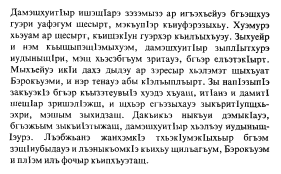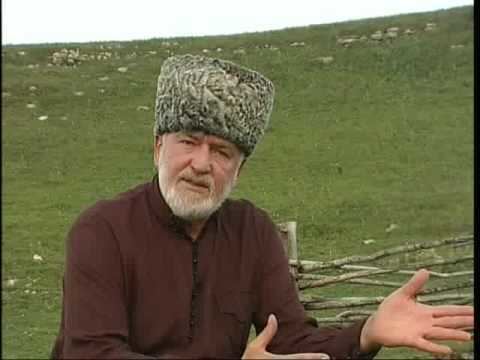 | ||
Native speakers circa 1,7 million (2005–2010) Language family Abazgi–Adyghe (isolate)AdygheKabardian Adyghe Official language in | ||
Kabardian language numbers
Kabardian (/kəˈbɑːrdiən/; Kabardian: Адыгэбзэ or Къэбэрдей Адыгэбзэ or Къэбэрдейбзэ qabardejbza ; Lowland Adyghe: Адыгабзэ or Къэбэртай адыгабзэ or Къэбэртайбзэ), also known as Highland Adyghe or Kabardino-Cherkess (Къэбэрдей–черкесыбзэ) or East Circassian, is one of the two literary dialects of the Adyghe (Circassian) language. It is closely related to Lowland Adyghe. The Kabardian Adyghe has two major sub-dialects, Kabardian and Besleney. Kabardians refer to their language using the Kabardian term адыгэбзэ adygèbzè (meaning the Adyghe language). It is spoken mainly in parts of Kabardino-Balkaria and Karachay-Cherkessia as well as in the United States, Ukraine, Turkey, Syria, Jordan, and Germany, amongst others (the extensive post-war diaspora). It has 47 or 48 consonant phonemes of which 22 or 23 are fricatives, depending upon whether one counts [h] as phonemic, but this is contrasted with just three phonemic vowels. It is one of very few languages to possess a clear phonemic distinction between ejective affricates and ejective fricatives.
Contents
- Kabardian language numbers
- Medieval Circassian Runes
- Sub dialects
- Phonology
- Consonants
- Vowels
- Grammar
- References

As a member of the Abazgi–Adyghe dialectic continuum, Kabardian is ergative and has an extremely complex verbal system. Kabardian is written using the Cyrillic script, and this serves as the literary language for the Adyghe people in both Kabardino-Balkaria (where it is usually called the "Kabardian") and Karachay-Cherkessia (where it is called the "Cherkess").

Since 2004, the Turkish state broadcasting corporation TRT has maintained a half-an-hour programme a week in the Terek sub-dialect of Kabardian.

In 2016, Yury Kokov proposed to create a common writing script which would unite both Lowland Adyghe and Kabardian Adyghe dialects.

Medieval Circassian Runes

The inscriptions of a Kabardian warrior from modern-day Rostov Oblast was found during excavations of the Saltovo-Mayatskaya Culture. The Circassian Runic inscriptions are displayed at the Novocherkassk Museum of Russia.
The Circassians had developed a runic alphabet in the 6–7th centuries. Runic inscriptions similar to the Kabardian (Kassogian) inscriptions were also discovered in Bessarabia.
Sub-dialects
Phonology
The phoneme written Л л is pronounced as a voiced alveolar lateral fricative [ɮ] mostly by the Circassians of Kabardino and Cherkessia, but many Kabardians pronounce it as an alveolar lateral approximant [l] in diaspora. The series of labialized alveolar sibilant affricates and fricatives that exist in Lowland Adyghe /ʃʷʼ/ /ʒʷ/ /ʃʷ/ /t͡sʷ/ became labiodental consonants /fʼ/ /v/ /f/ /v/ in Kabardian, for example the Kabardian words мафӏэ [maːfʼa] "fire", зэвы [zavə] "narrow", фыз [fəz] "wife" and вакъэ [vaːqa] "shoe" are pronounced as машӏо [maːʃʷʼa], зэжъу [zaʒʷə], шъуз /ʃʷəz/ and цуакъэ [t͡sʷaːqa] in Adyghe. Kabardian has a labialized voiceless velar fricative [xʷ] which correspond to Lowland Adyghe [f], for example the Lowland Adyghe word "тфы" ( [tfə] "five" is тху ( [txʷə] ) in Kabardian. In the Besleney sub-dialect, there exist an alveolar lateral ejective affricate [t͡ɬʼ] which corresponds to [ɬʼ] in literary Kabardian. Some Turkish Kabardians (Uzunyayla) and Besleneys have a palatalized voiced velar stop [gʲ] and a palatalized velar ejective [kʲʼ] which corresponds to [d͡ʒ] and [t͡ʃʼ] in literary Kabardian.
Consonants
- In Besleney sub-dialect and Uzunyayla Kabardian, there is a palatalized voiced velar stop [ɡʲ] and a palatalized velar ejective [kʲʼ] that were merged with [d͡ʒ] and [t͡ʃʼ] in most Kabardian sub-dialects. For example, the Baslaney words "гьанэ" [ɡʲaːna] "shirt" and "кӏьапсэ" [kʲʼaːpsa] "rope" are pronounced in other Kabardian dialects as "джанэ" [d͡ʒaːna] and кӏапсэ [t͡ʃʼaːpsa].
- Consonants that exist only in borrowed words.
The glottalization of the ejective stops (but not fricatives) can be quite weak, and has been reported to often be creaky voice, that is, to have laryngealized voicing. Something similar seems to have happened historically in the Veinakh languages.
Vowels
Kabardian consists of a vertical vowel system. Although a large number of surface vowels appear, they can be analyzed as consisting of at most the following three phonemic vowels: /ə/, /a/ and /aː/.
The following allophones of the short vowels /ǝ/, /a/ appear:
According to Kuipers,
These symbols must be understood as each covering a wide range of sub-variants. For example, i stands for a sound close to cardinal [i] in 'ji' "eight", for a sound close to English [ɪ] in "kit" in the word x'i "sea", etc. In fact, the short vowels, which are found only after consonants, have different variants after practically every series defined as to point of articulation and presence or absence of labialization or palatalization, and the number of variants is multiplied by the influence of the consonant (or zero) that follows.Most of the long vowels appear as automatic variants of a sequence of short vowel and glide, when it occurs in a single syllable:
This leaves only the vowel [aː]. Kuipers claims that this can be analyzed as underlying /ha/ when word-initial, and underlying /ah/ elsewhere, based on the following facts:
Halle finds Kuipers' analysis "exemplary". Gordon and Applebaum note this analysis, but also note that some authors disagree, and as a result prefer to maintain a phoneme /aː/.
In a later section of his monograph, Kuipers also attempts to analyze the two vowels phonemes /ǝ/ and /a/ out of existence. Halle, however, shows that this analysis is flawed, as it requires the introduction of multiple new phonemes to carry the information formerly encoded by the two vowel phonemes.
The vowel /o/ appears in some loan words; it is often pronounced /aw/.
The diphthong /aw/ is pronounced /oː/ in some dialects. /jə/ may be realised as /iː/, /wə/ as /uː/ and /aj/ as /eː/. This monothongisation does not occur in all sub-dialects.
The vowels /a, aː/ can have the semi-vowel /j/ in front of it.
Grammar
Kabardian has a basic agent–object–verb typology, and is characterized by an ergative construction of the sentence.
